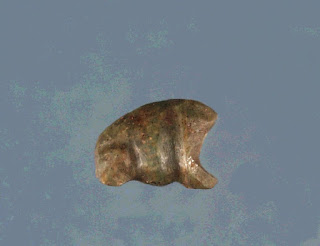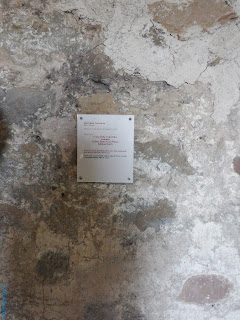miércoles, 18 de noviembre de 2015
A fragment of a relief
A fragment of a relief. Figures in a precession playing the sistrum. Country of Origin: Egypt. Culture: Ancient Egyptian. Date/Period: 18th dynasty c.1345 BC. Place of Origin: El Amarna. Material Size: Sunk relief in limestone. Credit Line: Werner Forman Archive/ Private Collection
amulet snake
Crudely incised stone amulet of a rearing cobra, emblem of the divine forces protecting the creator, king and creation, with a suspension loop above the head. The cemetery where this was excavated lies near the villages of el-Riqqeh and Girza, not far from the Residence of the Middle Kingdom kings at Itjtawy (probably modern el-Lisht). The piece was found in the intact New Kingdom burial of a woman, whose body lay in a grave measuring 90 by 60 by 85 inches, the head to the east and the face turned to the north. The coffin was of pottery, and the grave-goods included two stone cosmetic dishes, blue glass beads, a mirror, two gold penannular ear-rings, and a cowrie-shaped seal-amulet and scarab amulet. Together the group presents the items of adornment treasured by a relatively well-to-do lady of the late 18th Dynasty, when Egypt was at the peak of her power, about 1350 BC.
EL-RIQQEH
BASALT ?
18TH DYNASTY
NATIONAL MUSEUM OF IRELAND
globalegyptianmuseum
Schematically cut green stone amulet in the form of a frog,
Schematically cut green stone amulet in the form of a frog, a popular amulet from predynastic times onwards.
OLD KINGDOM ?
NATIONAL MUSEUM OF IRELAND
globalegyptianmuseum
sábado, 14 de noviembre de 2015
amphora fragment
amphora fragment, silen
Naukratis Egypt
Beazley, J. D.. 1956. Attic black-figure vase-painters.
129
...
Naukratis Egypt
Beazley, J. D.. 1956. Attic black-figure vase-painters.
129
...
Lamb, Winifred. 1936. Corpus vasorum antiquorum. Great Britain ; fasc.11, fasc.2. Cambridge.
pl. 20 (499) 36
Accession:
Object Number: GR.192.1899
http://webapps.fitzmuseum.cam.ac.uk
pl. 20 (499) 36
Accession:
Object Number: GR.192.1899
http://webapps.fitzmuseum.cam.ac.uk
DUAMUTEF
Small faience plaque with two-dimensional depiction of a jackal-headed mummiform god, to be identified as Duamutef, one of the four sons of Horus (protective guardians of the internal organs removed and embalmed separately in mummification).
DUAMUTEF
NATIONAL MUSEUM OF IRELAND [30/002]
...
DUAMUTEF
NATIONAL MUSEUM OF IRELAND [30/002]
...
globalegyptianmuseum
Pendant with the name of Akhenaten
Pendant with the name of Akhenaten
Moulded blue faience pendant in the shape of a cartouche containing the throne name of Akhenaten, broken below the centre point. Rings and pendants bearing the name of the king were recovered in large numbers from the excavations of his city at el-`Amarna. Their precise source and significance is unknown; possibly such personal tokens of loyalty may have been distributed from the palace at important festivals.
Present location | NATIONAL MUSEUM OF IRELAND [30/002] DUBLIN |
Inventory number | E72:122 |
Dating | 18TH DYNASTY |
Archaeological Site | UNKNOWN |
Category | JEWELLERY |
Material | FAIENCE |
Technique | PRESSED IN A FORM/MODEL |
Width | 1.1 cm |
Translation
Neferkheper[u]ra [...].
globalegyptianmuseum
Jarra de leche pintada con una banda blanca
Jarra de leche pintada con una banda blanca, con dos picos en forma de senos, y borde con impresión de cuerda. Aunque resulte extraño, las jarras con senos pertenecen al Segundo Período Intermedio y comienzos de la Dinastía XVIII. La forma y la decoración son típicas del Alto Egipto. Esta pieza fue descubierta en Abydos, formando parte del ajuar funerario de un enterramiento bastante bien equipado.
SEGUNDO PERIODO INTERMEDIO
NATIONAL MUSEUM OF IRELAND
globalegyptianmuseum
Qau Tomb 685
Qau Tomb 685
date: Fifth to Sixth Dynasty
undisturbed tomb, the sex of the buried person is not certain, perhaps a woman
measurements: 0.46 x 1.44 x 1.73 (depths) m
http://www.ucl.ac.uk/
vessel
vessel
neck-amphora fragment, sirens
Naukratis Egypt
Lamb, Winifred. 1936. Corpus vasorum antiquorum. Great Britain ; fasc.11, fasc.2. Cambridge.
pl. 19 (498)
http://webapps.fitzmuseum.cam.ac.uk
Estatuilla de Padiiset.
Estatuilla de Padiiset.
En basalto y que fue usurpada por ese personaje
Inscripción: Ka de Osiris: Pa-di-iset, el justo, hijo de Apy.
El único renombrado, el imparcial enviado/comisionado/mensajero de/para Canaán de/para Peleset, Pa-di-iset, hijo de Apy.
Walters Art Museum
Walters Art Museum
Suscribirse a:
Entradas (Atom)

















































